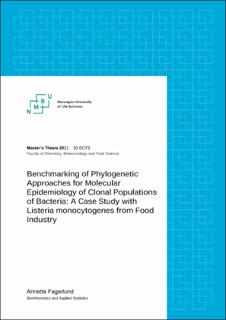| dc.description.abstract | Listeria monocytogenes is a foodborne pathogenic bacterium with a clonal population structure. It is widely distributed in natural environments and can establish and persist in food processing factories for years, making it a major challenge to the food industry. Recent advances in whole genome sequencing technology have opened the possibility for enhancing food safety management by tracking the pathogen in the factory environment and through food chains. For optimal use, such monitoring would be dependent on efficient approaches for determining the genetic relationships between bacterial isolates. Alignment-free options for sequence comparison, often based on k-mer analysis, have become increasingly popular in recent years due to their ability to efficiently analyse large volumes of next-generation sequencing data. In the current work, the performance of four alignment-free sequence comparison methods; kSNP3, co-phylog, phylonium and Mash, was benchmarked against the two most commonly used approaches within genomic epidemiology today, namely reference-based SNP calling and whole genome MLST (wgMLST). The analysis was conducted using a dataset of 769 L. monocytogenes genomes from food industry. The performance of each method was evaluated using correlation analysis for comparison of pairwise genetic distances and a generalized Robinson-Foulds measure to compare the topology of phylogenetic trees inferred for closely related genomes. The results showed that all four alignment-free methods were able to identify the genetic clusters defined using the benchmark method, when draft genome assemblies were used as input data. Judged by the correlation analysis, Mash was the best ranking alignment-free method, while co-phylog obtained the best score when Neighbor Joining trees generated from pairwise genetic distance matrices were compared with the benchmark Maximum Likelihood trees based on SNP alignments. In fact, all four alignment-free methods were able to generate trees which on average scored better than trees based on the core genome MLST (cgMLST) method, which is perhaps the most commonly used method for surveillance and outbreak detection for foodborne pathogens today. | en_US |

